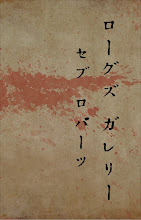I'm in the enviable position of having seen almost all the bands on the bill of which I'm particularly fond. (Om and Harmonia, I'll hunt you down one day.) One band my 20-yr-old self would've drawn blood to see was Lightning Bolt, but in the years since I've actually passed up every chance I've had. It wasn't the numbing homogeneity their music betrays over several albums, nor was it part of some larger aesthetic shift in my listening habits. So why couldn't I be arsed to see one of the hot-shit live acts of the new millenium? It has something to do with Amy Phillips' impression of LB's Saturday night ATP set:
As usual, Lightning Bolt set up on the floor rather than the stage. As usual, it was only the most aggressive people who got to actually see Lightning Bolt. I've been to a handful of Lightning Bolt shows, and I've never been able to see more than the tops of Brian Chippendale's and Brian Gibson's heads. This time was no different. I think I counted maybe three girls inside the inner circle of normally wimpy dudes getting their slamdance douchebag on. Lightning Bolt's set was the one time during the entire weekend that ATP NY didn't feel like a happy, inclusive community.Let's repeat those last seven words for emphasis: didn't feel like a happy, inclusive community. But isn't the point of their in-audience positioning to pulverise the fourth wall, to dynamite the pedestal upon which performers loom over their audience? Yes, but it also serves to construct an entirely different kind of barrier.
If he figures out what is "happening," he can rise one notch - and become Hip. Then if he can convince himself to approve of what is "happening," then he becomes Groovy. And after that, he can actually raise himself to the rank of Cool. He can become one of those... cool guys.And what is the key to being able to decode, accept, and successfully navigate such arcane, unrooted etiquette? Proximity. If you're not literally in, then you are doomed to being out. Which is exactly what happens at a Lightning Bolt show, a veritable diorama of hipster social structure.
The on-the-floor set-up is a bold rebuff of the "straight world," the hipster mission statement physically manifest: any two square meters of pavement is a performance space! Refuse the plastic idolatry of the stage! No guest-list gladhanding or AmEx Black card privilege will land you in the front row, because floor plans be damned! We are all part of the same sweaty embrace! But what is populist in its pretense is exclusive in its practice. The full thrall of sound & sight is enjoyed by only the elect few - that is, the scene players already aware of the ritual's conformation who jockey the most aggressively for position. Physically walled off by the corona of the crowd, those at a distance are left to piece together some sad shred of enjoyment from whatever sonic & visual scraps escape the ecstatic nucleus. Is it supposed to sound so muddy? What was churning within that sea of heads? What am I missing? These can only be answered with that most segregative of rejoinders: "If you have to ask, you'll never know." And you'll never know because you're not allowed.
Hip-hop also offers different ways of approaching the stage. Though regional snobbery can quickly become grating, an MC's focus on their local social reality necessarily means their music is in rooted in their community. For all of hip-hop's narcissistic self-aggrandizement, the music only rings true if it's reflective of some collective experience. That's why it's never just a solo artist onstage: as corny a carnival barker as a hype-man can be, he's there because the star MC and his friends are there to convey their message together. When was the last time a member of the Wu-Tang Clan appeared alone? Like they said, "We gonna swarm!"
Similarly, the best battle-rapping can't rely on a vast vocabulary alone. The victor is most often whoever can appeal the most effectively to the audience, converting the crowd from objective spectators to a united front in the war of words. That the MC is onstage becomes irrelevant, because the audience is right there with them: they got his back.





2 comments:
if she could only see the tops of their heads how did she know the genders of the people watching?
Hair clips, ribbons, and pigtails - duh!
Post a Comment